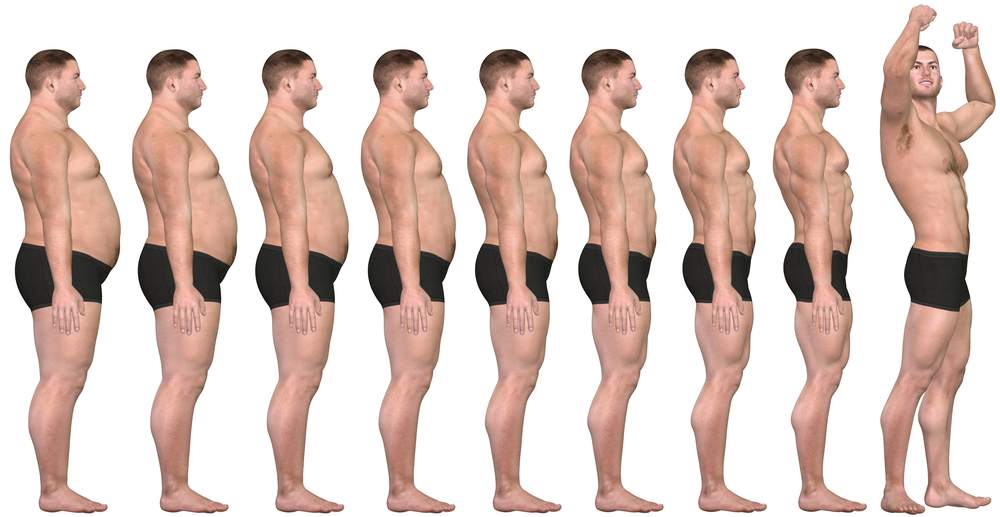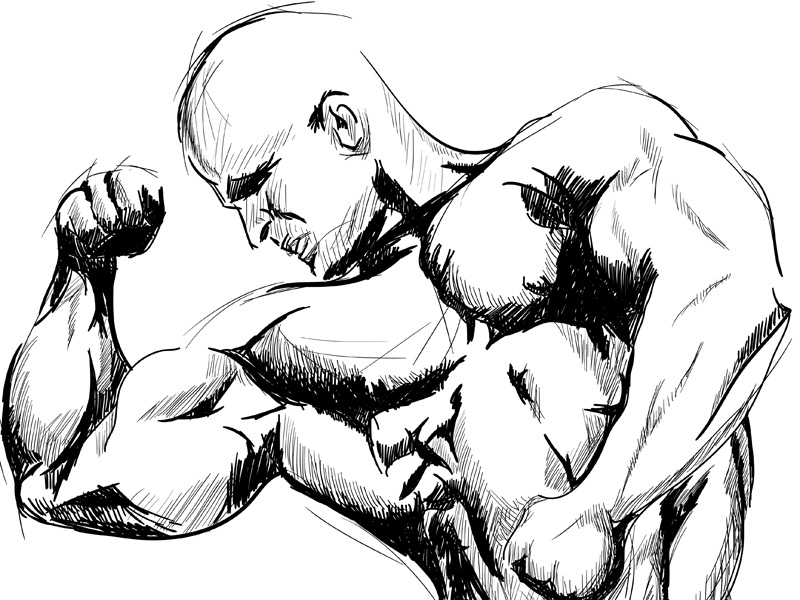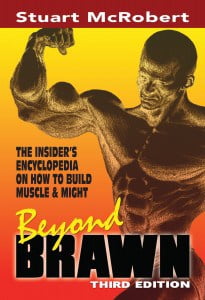Excerpts
Where you stand in the spectrum of bodybuilding potential
 Dividing a random sample of drug-free bodybuilders into degrees of “hardgainingness” can’t be done accurately because of the difficulty of specifying, identifying and then quantifying with consistency the characteristics of bodybuilding potential. But for the purpose of getting at least an approximation, here are some suggested figures.
Dividing a random sample of drug-free bodybuilders into degrees of “hardgainingness” can’t be done accurately because of the difficulty of specifying, identifying and then quantifying with consistency the characteristics of bodybuilding potential. But for the purpose of getting at least an approximation, here are some suggested figures.
At the “hardest” end of the gaining spectrum are the near-zero gainers who, for reasons of health or extreme structural problems, find it almost impossible to gain (but not impossible if they train and recuperate properly). They number fewer than 5% of any random sample from the training masses.
Bodybuilding’s genetic freaks
At the “easiest” end of the spectrum are the super easy gainers who have phenomenal genetics and fantastically-responsive bodies. The phenomenally blessed — the genetic freaks, and I’m not using “freaks” in a pejorative sense — number much fewer than 1% of the whole training population.
The genetic freaks have a blend of bodytype, muscle insertion points, neuromuscular efficiency, muscle belly length, muscle fiber type and number, tendency for leanness, and recovery abilities that give them a tremendously responsive body. For competitive bodybuilding there are pivotally important aesthetic factors that are also genetically determined. See BRAWN for a detailed discussion on how genetic freaks are assembled.
Bodybuilding’s “regular” easy gainers
Behind the extremely responsive easy gainers are the “regular” easy gainers who are able to gain to some degree on most programs, although they don’t have the talent to become fantastic unless pumped to their jowls with chemicals. There’s a considerable number of these easy gainers, perhaps as many as 10% or so of a random sample of weight trainees. It’s this group that provides gyms with most of their successes. But these successful trainees use programs which are training suicide for genuine hardgainers. Many trainers and coaches belong to the category of “regular” easy gainers. But these easy gainers often have a body part and an exercise or two they struggle in, relatively speaking. While easy gainers typically adhere to conventional training routines, and often gain well from them, they gain far more when they adopt programs like those described in this guide.
Bodybuilding’s “regular” hardgainers
Near-zero, easy and extremely easy gainers total about 15% of a random sample of trainees, leaving 85% or so who are “regular” hardgainers that get nowhere using popular routines. (These approximate percentages are strictly for a drug-free population. Drug use would distort the percentages.) Hardgainers have a lot of potential for growth, but to realize it they must train appropriately. The harder a gainer you are, the less room for error you have in your exercise, rest and nutrition program, and the more educated you need to be. This book will educate you.
Although “hardgainer” is a well used term in the bodybuilding world in particular, and also used in this book, it’s actually a misnomer. Because hardgainers are the majority it would be more accurate to call them “normal” gainers. As it is, the term “hardgainer” implies a condition that’s abnormal.
Your bodybuilding priority
Whatever genetic potpourri you’ve been dealt is all you’re going to get. Whatever shortcomings you may have, you have to live with. Rather than spend time complaining about your genetic fate, pour your energy into achieving your genetic potential. An average or even a less-than-average potential for bodybuilding, if achieved, is stunning to an untrained person, and respected by almost any trained individual.
Focus on achieving your bodybuilding potential, not on comparing yourself with ideals. Apply yourself intelligently and you may discover that what you thought was a modest potential is actually a lot more.
If you’re consumed with the achievements of others, enviously look at the natural talents of a gifted but tiny minority, and bemoan your own genetic fate, you’ll never deliver the consistent and savvy dedication needed to do what will satisfy you most of all — the full achievement of your own bodybuilding potential.
The thrill of bodybuilding

The power to change one’s own physique is one of the biggest appeals of bodybuilding, if not the biggest. Lifting weights is a solo activity over which you alone have the power of control. Once you know what to do, you need rely on no one.
No matter where you are now — big or small, strong or weak, young or not so young — compete with yourself. It’s you, against you. Progress is measurable, and concrete. It can be as little as just one more rep than last week in a given exercise, with the same poundage. Or it could be the same rep count but with an extra pound on the bar. Or it could be one of several other indicators of progress.
All of these small doses of progress are little thrills you’ll never tire of. They make bodybuilding a fabulous activity. But you can’t experience this unless you implement a productive interpretation of training.
Physique improvement and strength training aren’t just about getting bigger and stronger muscles, although, of course, they’re hugely satisfying in themselves. Training is also about enjoying exercise, and making yourself fitter, more flexible and healthier, and about strengthening your mind, self-esteem and confidence.
Although physically hard to do, training satisfies a basic human need for physical effort. No matter where you are now, you can take delight in realizing some new goal in the physical sphere.
But none of this can happen unless you rate exercise high in your priorities. Resolve, now, to give your exercise program and dietary discipline the priority they deserve. Get on course for realizing the physical qualities you admire. Put a spark in your life through bodybuilding.
Not only will you look and feel great, and maintain your physical youth, but you’ll love the journey there and the knocking off of all the little targets; and revel in the pleasure that exercise brings.
Each of us can create a utopia of training sanity, and develop ourselves so that we’re outstanding in the minds of untrained people. We can then present ourselves as examples of how training works for “average” people.
Resistance training is one of man’s finest discoveries. So that you don’t miss your chance to benefit from it, learn how to train and recuperate properly.
A bodybuilding plan for success

Get yourself onto a bodybuilding plan for success. Most bodybuilders have no such plan, and severely hinder their rate of progress as a result.
Bodybuilding success isn’t a hit or miss activity. It’s planned. If you put together an intelligent program, tailor it according to your own individual recuperative abilities, follow it diligently and conscientiously for long enough, and fully satisfy your rest, sleep and nutritional needs, you will get much bigger and stronger muscles. Sensible weight-training programs work. But too few people know what sensible programs are, and too few bodybuilders are targeted at specific goals by specific times.
Daily units, and your long-term bodybuilding plan
Not living in the past, and not living in the future, but riveting most of your attention on the present is the only way to make sure you get most if not all of your “todays” in good order. If you don’t get the daily units right, you don’t have a hope of long-term success.
There’s a strong connection between the daily units and your long-term goals. Getting the latter in good order provides the overall strategy into which the daily units slot. Regular reminders of the long-term programming keep you on track for getting the daily units right.
Competitive athletes have a major advantage over non-competitive ones — the motivating, focusing, pressurizing and concrete-goals-creating effect of competition. The need to be your best at a certain date and place will dramatically focus your attention, and force you to be more efficient with your time. Without a definite where and when to be at your best, human nature makes most people casual with their time. You may take years to get to where you could have gotten in just six months had you been nailed down to a rigorous schedule to get things done on time.
Deadlines are often imperative for making people take action, in all areas of life. Consider how many things you need to do but have been procrastinating for weeks because you don’t have a fixed deadline to do them by. But give something a deadline and urgency, and it usually gets done.
Nail yourself to long-term deadlines. Make your goals specific by writing down numbers and deadlines, for example. Then nail yourself to the daily must-dos in order to keep on schedule for reaching the long-term goals.
There’s nothing like the urgency of concentrating on a specific goal by a specific deadline to focus attention, application and resolve. Without something specific to rally attention and resources, people tend to drift along and never get even close to realizing their potential. As the months go by there’s little or no improvement.
Set the goal(s), make your plans, focus your application, dedicate yourself, and then start making month-by-month improvement a reality. And then when you’ve achieved your medium or long-term goal(s), do it all over again, and then again, and again. Then you’ll set yourself up to achieve more over the next twelve months than perhaps you achieved over the previous few years. And whatever you learn from the value of nailing yourself to targets and deadlines in the physique and strength spheres, apply it to the rest of your life.
There are deadline situations that can rivet attention just as well as formal bodybuilding or lifting competitions. Some of them may seem too simple, or even trite, but they work if you work.
Six tactics for yielding long-term success are then detailed in BEYOND BRAWN.
But all the determination in the world counts for nothing if you don’t know how to train effectively, although having a high level of determination usually speeds up the learning process.
Treat each self-imposed deadline as a major part of your life. If you treat the deadlines casually, you may as well not bother going through the process of aiming to be your best by a given date. As with everything in training, you must take what you’re doing very seriously. Hardgainers have little room for error, whereas easy gainers can make many errors and yet still gain.
Give your 100% best to a good overall plan broken down into daily units, and you’ll amaze yourself with how much you can achieve. Compare the sort of attention you’ve given your training over the last year, with the sort of application I’m recommending here, and you’ll probably find a big difference.
If you want to be successful in achieving your bodybuilding potential, you need to program that success. Stop leaving life to chance. Forget about the indifference and disorderly state of some others, and don’t let any negativity rub onto you.
It doesn’t matter a whit what other people are doing with their training. Your own life is what matters the most to you. Get in charge, and make the most of it!
How to avoid overtraining
 The inability of most bodybuilders to recognize the symptoms of overtraining is at the root of their training problems. But recognizing the symptoms is only the start. You need to know how to respond to the early symptoms—immediately—if you’re to escape the misery that accompanies chronic overtraining.
The inability of most bodybuilders to recognize the symptoms of overtraining is at the root of their training problems. But recognizing the symptoms is only the start. You need to know how to respond to the early symptoms—immediately—if you’re to escape the misery that accompanies chronic overtraining.
This is a very serious issue for all bodybuilders.
Serious hard-gaining bodybuilders have the persistence required to soldier on even when the going gets tough. Persistence is usually a desirable trait. But when it comes to dealing with the warning signs of overtraining, persistence can be destructive.
You must train within your body’s ability to recuperate. Never mind what someone else can recuperate from. Someone else is not you.
Overtraining arises when the body is exposed to more stress than it can deal with.
It may be that you’re training too frequently for the exercise load you’re under, or that you’re training too much each workout for the frequency you’re using. But overtraining is usually much more complex than that.
Overtraining doesn’t occur overnight unless you greatly increase your training load and/or have some drastic reduction in the quality of your rest, sleep and nutrition, and/or have a crisis in your personal life that wipes you out. Overtraining is usually an accumulative process of weeks and months of demanding too much from your body, and ignoring the warning signs of impending chronic overtraining.
When on the edge of overtraining you may still creep forward in the gym; but things will fall apart as you reach the exhaustion point of your recovery abilities. Then, unless you back off, your body will crumble.
Growing bigger and stronger is your body’s response to the stress you impose on it from training hard on appropriate routines. Getting unusually strong and big demands an unusual degree and type of stress, but there’s a fine line between doing enough and doing too much.
Even when you think you can cope with a very heavy stress level, such as at the end of a training cycle when you’re pushing full-bore, your body is taking such a battering that your immune system is suppressed to a degree. This increases your chance of sickness.
When you’re riding the crest of a wave of effort and progression in the gym, don’t think that you’re indestructible. At such a time, take an extra day or two of rest between workouts, reduce your training volume a little, sleep more, eat better, and be super attentive to recovering fully between workouts. Do all this so that you don’t go from being “indestructible” one day, to being laid low with an illness the next.
Stress itself isn’t bad, but an excess of stress relative to what you can deal with is bad. An over-stressed body regresses. This is Nature’s way of forcing you to cycle your training intensity. Whether you like it or not, you’ll end up cycling your training intensity to some degree, whether you do it intentionally (by deliberately backing off at times) or have it forced upon you by injury or illness.
Symptoms of overtraining
Before you can take action in response to warning signs of overtraining, you need to know what those signs are. While the following 17 symptoms are accurate for the typical non-competitive bodybuilder, including those who are advanced, the very advanced and competitive elite may exhibit different symptoms of overtraining. This list isn’t presented as an exhaustive study.
1) Stagnated training poundages, perhaps even before you’ve reached your most recent best training weights. One or two bad workouts doesn’t necessarily mean you’re overtrained. All bodybuilders have the occasional bad workout that should be written off. But when you have three or four consecutive bad workouts, you’re almost certainly overtrained.
2) Reduced enthusiasm for training, i.e., not looking forward to training as much as usual, and having trouble getting a workout finished without cutting corners. (This could, however, be caused by out-of-the-gym distractions.)
3) A body that’s more tired and sore than usual in the days following training. You’ll not bounce back from the healthy feeling of fatigue that follows a great workout, despite perhaps sleeping more than usual.
4) Even though you feel very tired, you may have trouble getting to sleep and/or have trouble getting back to sleep when awoken during the night.
5) An increasing number of minor aches and pains, and ones that don’t heal.
6) Reduced appetite and food intake.
7) Reduced level of concentration during each set.
8) Being more irritable and less patient in your life in general.
9) Being anxious about your training not going well.
10) Feeling under the weather.
11) Getting frequent colds.
12) Diminished endurance—formerly moderate-intensity aerobic work starts to feel demanding. The perceived exertion from the aerobic exercise increases.
13) Legs feel heavy, in and out of the gym, and all activities seem to involve more effort than previously.
14) Increased resting heart rate.
15) Increased diastolic blood pressure.
16) An inclination for corner cutting in any training-related issue, including your nutrition.
17) Losing interest in reading bodybuilding magazines and books.
Many of the above can, however, be the result of out-of-the-gym factors. Even in those cases it’s still wise to back off to a reduced training intensity until your life and recovery machinery are back to normal.
Be honest with yourself. Discover if you have any genuine symptoms of overtraining. You may suffer from at least several of the symptoms. If so, face the fact that you’re overtrained and need to adjust your training so that the symptoms of overtraining don’t persist. Don’t be guilty of denial.
You’ll not increase your muscle mass through overtraining!
Local soreness and systemic fatigue are part and parcel of training. There is, however, a huge difference between post-workout systemic fatigue that’s a high from training, and the fatigue that’s almost debilitating. To train hard, and have a shower followed by a good meal, leaves a sense of achievement and a well-worked feeling that’s a joy. To beat yourself into the ground once you’re already tired and dragging yourself around, as in an overtrained state, produces no post-workout high.
The above is an excerpt from Chapter 14 of BEYOND BRAWN. For the causes of the overtrained condition, how to react to signs of overtraining, and the full account of how to avoid overtraining ruining your bodybuilding progress, please see the rest of Chapter 14.
Please check out this book’s table of contents to discover the extent of the guidance provided in this famous bodybuilding guide.
How to deadlift 400 pounds for 20 reps
 This chapter is included in BEYOND BRAWN for five reasons:
This chapter is included in BEYOND BRAWN for five reasons:
1. To show that a typical hardgainer, if not restricted by age or structural problems, can build up to respectable weights—in my case bent-legged deadlifting 400 pounds for 20 consecutive rest-pause reps.
2. To explain the real-life, step-by-step practicalities of a training cycle, how a cycle is modified as it evolves, and how the ups and downs of life have to be accommodated.
3. To take you through the key lessons learned.
4. To confirm that I’m no armchair instructor.
5. To show that abbreviated, basics-first training works.
This chapter is a revised and expanded version of an article published in issue #21 of HARDGAINER magazine (November-December 1992). You’re not going to get just the positive side of the training cycle. You’re going to get the full story, to help equip you to avoid the mistakes I made.
The background of the deadlift cycle
The first requirements for realizing a very demanding goal are lots of resolve, heaps of persistence, and tons of effort. Whether your demanding goal is 300 x 20 in the squat, 350 x 20 in the deadlift, 300 x 5 in the bench press, or whatever, you really have to want it. There’s no easy way to reach a demanding goal. If you don’t want it enough to pay your dues, overcome expected and unexpected obstacles, and give your pound of flesh, you’ll never get to your goal. The names of our game are effort and progressive poundages. While cycling training intensity doesn’t mean full-bore effort at every workout, you must deliver sustained periods of intensive workouts.
There are two crucial considerations to keep in mind when viewing my personal training achievements:
a. I’ve never taken bodybuilding drugs, and never will.
b. My overall genetic endowment is almost the opposite of what’s needed to develop outstanding muscle mass and strength.
While 400 x 20 is fine deadlifting for a hardgainer, it’s not much in today’s world where the genetically gifted elite grab the publicity and attention. But while some of these men are awesomely strong, more than a few of them are far less strong than their posed lifts (sometimes using fake plates) suggest. I didn’t use a lifting belt or any lifting gear other than grip support. I was 195 pounds—at 5-9—when I did the 400 x 20, so I was pulling over twice bodyweight. This was in July 1992 when I was 33 years old.
When appraising my genetics for lifting weights, there’s nothing to marvel at. Two areas come out as better than average, i.e., calves, and body structure for the deadlift and the stiff-legged deadlift. Everything else ranges from average hardgainer material to worse-than-average.
I had extensive work and parental responsibilities during the deadlift cycle. These prevented my resting and sleeping as well as I should have in order to recuperate speedily from training. I’m a real-world person, not someone who can devote himself to his training with little or no thought for other aspects of regular life. As typical working hardgainers it’s not just our genes that work against us. There are other out-of-the-gym factors as well.
Reasoning for the deadlift focus
Until this 400 x 20 deadlift cycle I considered the barbell squat to be the exercise to concentrate upon. While my deadlift poundage can almost be depended upon to increase so long as I’m injury-free, train very hard and infrequently, and eat and rest enough, the same can’t be said of the squat. For years I tried to make the most of a relatively poor body structure for squatting (my legs are overly long in relation to the length of my torso), and I neglected to apply myself to an exercise I’m mechanically much better suited to—the deadlift.
As it was, I spent many years focusing on the squat while omitting the deadlift. The 1992 experience proved that while my back and knees would cave in from the squat, the deadlift could be kept moving.
I’m not in a minority of one on this point; and I believe that the minority is substantial among hardgainers. If you can’t get good results from the barbell squat despite training it hard and with persistence—and assuming that you know what correct squatting technique is—promote the bent-legged deadlift, especially using the parallel-grip bar, to at least equal status with the squat. (But not the stiff-legged deadlift, because it doesn’t involve the quadriceps.)
Beginners and early intermediates should give equal priority to the squat and the deadlift in their training. But once they have reached the intermediate stage—when they look like they lift weights—they should be able to see how they compare in the two exercises. Assuming the same degree of application to each exercise, if your squat is about the same or ahead of your deadlift, you have a squatter’s body structure. If your deadlift is well ahead of your squat, it’s the deadlift that’s favored by your body structure. At this stage, at least some of the time, you should have specialization cycles in which you focus on the exercise you naturally favor. Make the most of whatever natural bias you have. While the very gifted can do very well in almost every exercise, the rest of us may have to settle for finding just one or two exercises in which to excel, but without neglecting other areas.
I started weight training in 1973. I got little or nothing out of most of those years other than lots of experience of what doesn’t work despite single-minded determination and application. I never got into any variation of the deadlift in a serious way until about 1988. Until then it had been the barbell squat for my thigh, hip and lower back structure. I then got into low-rep deadlifting. After about three years of hard work on both the stiff-legged and bent-legged versions, but not both of them in the same cycle, I was capable of deadlifting 500 pounds. I was, however, still giving more focus to the squat, but wasn’t getting results proportional to my application.
During the deadlift-focus period I’m now going to describe I found I could progress on the deadlift akin to how the famous squatters did on the squat—train hard, rest a lot, eat well, and add weight to the bar almost every week, and do so for a long time. This was so satisfying and made me wonder what I might have done had I grasped this important reality early in my training life.
The above is an excerpt from Chapter 17 of BEYOND BRAWN. For all the details of Stuart’s training cycle that culminated in the 400 x 20 deadlifting, and the many important lessons you can learn from this cycle so that you can boost your own bodybuilding progress, please see the rest of Chapter 17.
Please check out this book’s table of contents to discover the extent of the guidance provided in this famous bodybuilding guide.

